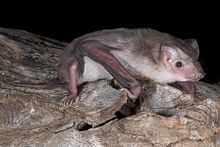| Ozimops beccarii | |
|---|---|

| |
| Conservation status | |
 Least Concern (IUCN 3.1) | |
| Scientific classification | |
| Domain: | Eukaryota |
| Kingdom: | Animalia |
| Phylum: | Chordata |
| Class: | Mammalia |
| Order: | Chiroptera |
| Family: | Molossidae |
| Genus: | Ozimops |
| Species: | O. beccarii |
| Binomial name | |
| Ozimops beccarii Peters, 1881 | |
| Synonyms | |
| |
Beccari's free-tailed bat (Ozimops beccarii) is a species of bat in the free-tailed bat family Molossidae found to Indonesia and Papua New Guinea. It can be found in several habitat types, including savanna, tropical moist forest, and fragmented and urban habitat. It roosts in trees, caves, and buildings in small colonies. This is a common species which is not considered to be threatened. The names Beccari's free-tailed bat or Beccari's mastiff bat once applied to populations in Australia.
Taxonomy and etymology
Ozimops beccarii was described as a new species in 1881 by German naturalist Wilhelm Peters. The eponym for the species name "beccarii" is Odoardo Beccari. Beccari discovered the holotype on Ambon Island of Indonesia. It was formerly considered native to Australia, but in 2014, the Australian population known as M. beccarii or M. beccarii astrolabiensis was distinguished as a full species, Mormopterus lumsdenae.
Biology and ecology
The species is known to roost in human structures such as houses. Additionally, it has been found in Melaleuca tree hollows; one individual was documented using a cave.
Range and habitat
Ozimops beccarii is found in Indonesia and Papua New Guinea. It has been documented from 0–300 m (0–984 ft) above sea level.
Conservation
As of 2017, it is evaluated as a least-concern species by the IUCN. It meets the criteria for this classification because its apparently preferred habitat is abundant; the species is likely widespread; and no major threats have been identified. It is infrequently encountered and known from only about twenty localities. The low number of records is likely a result of lack of survey effort in the region, however. Its population likely exceeds 10,000 individuals.
References
- ^ Reardon, T.B. (2017). "Ozimops beccarii". IUCN Red List of Threatened Species. 2017: e.T13880A154818942. doi:10.2305/IUCN.UK.2017-2.RLTS.T13880A154818942.en. Retrieved 19 November 2021.
- Peters, W. (1881). "Über die Chiropterengattung Mormopterus und die dahin gehörigen Arten". Monatsberichte der Königlichen Preussische Akademie des Wissenschaften zu Berlin (in German). 1881: 484.
- Reardon, T. B; McKenzie, N. L; Cooper, S. J. B; Appleton, B; Carthew, S; Adams, M (2014). "A molecular and morphological investigation of species boundaries and phylogenetic relationships in Australian free-tailed bats Mormopterus (Chiroptera : Molossidae)". Australian Journal of Zoology. 62 (2): 109. doi:10.1071/ZO13082. hdl:10536/DRO/DU:30070309.
| Taxon identifiers | |
|---|---|
| Mormopterus beccarii | |
| Ozimops beccarii | |